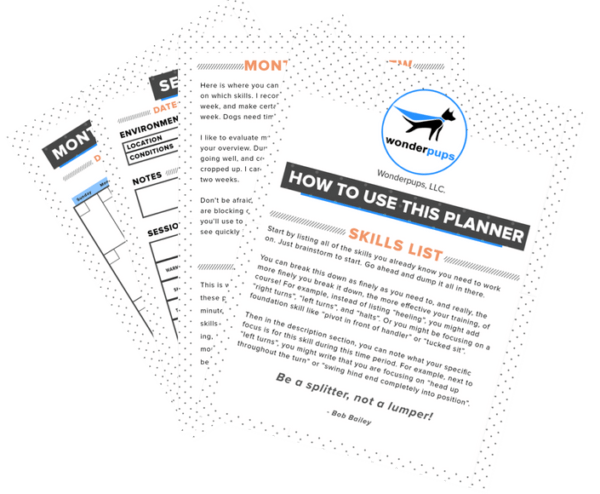One of the challenges of learning “stay” from the dog’s perspective, is humans often want to teach it in a very vague manner, which leaves the actual stay itself very poorly defined.
It’s compounded by the fact that we usually aren’t thinking very much about sitting or standing, and certainly not at all about lying down. How much mental awareness do you have right now keeping you in your chair? Hopefully not a lot (unless you are reading this from the international space station), or you’d have a hard time concentrating on this riveting article.
More than likely, the primitive, unconscious parts of your brain are busy taking the task of keeping you in your chair off your hands (figuratively), so you can use the big, fancy, conscious part of your brain to read every profound, meaningful word I write. Like this one: doppelgänger. And this one: parsnip. Ok, I’ll stop. The result though, is that you may shift position or cross your legs, AND HAVE NO IDEA THAT YOU’VE EVEN DONE IT. Because you aren’t consciously thinking about sitting.
We often approach teaching stays as a “stay there until I say it’s ok to get up”. But that leaves two possible problems:
First, there is often an implied “or else”, which can lead us down a path to less compassionate methods. I’ve noticed this can be a tough, last hold over for the crossover trainer. Even the most well-intentioned positive trainer can feel an uncomfortable conflict when the dog breaks a stay, and an urge to “do something about it”. After all, we can’t let him “get away with it”, right? (That way, there be dragons…)
Second, “ok to get up” isn’t an easy to define behavior. Again, this circles back to the “or else”. We can only really define “ok to get up” by defining everything before it as “not ok”… and what makes something not ok? Not usually good things. So the dog is left with out a clear ending to the stay. And if he’s not consciously aware of sitting (or laying down) in the first place, without clear boundaries, the stay itself is not well-defined.
And if Not Staying has perhaps been associated with unpleasantness, even very mild social displeasure from the handler, we can get all kinds of weird fall out… dogs avoiding the stay situation entirely either physically by leaving the area entirely or mentally by turning off and sniffing. Dogs that leave the stay and then avoid the handler (even worse, because now we have a potential safety situation). Or the flip side, dogs that stay put but get stuck or throw conflicted signals, a big problem for an agility start line stay where we want a snappy and connected explosion out of the stay. “Is it ok to get up now? Are you sure? Really sure? This is a trick. Really?”
What’s the solution?
Let’s be crazy and turn this whole thing over on it’s head. Ultimately, many dogs have trouble learning to stay because they haven’t learned to release. So instead of defining the release as “ok to stop staying”, let’s define stay in terms of waiting for the release! This takes the burden of what to do if the dog “stops staying” off both the dog and handler.
Wait, what? I know, hang on and bear with me…
So a different way to think about stays is to actually treat the release AS a behavior itself. The behavior can be any moving behavior you want: stand up, take the jump, touch my hand, run to the toy, etc. But the more specific the better. These are easy behaviors to teach and put on cue. Very clean, very straightforward. Once we have that task done, now we have the perfect tool to define our stay behavior.
By clearly defining the behavior that follows the stay as a movement, now the stay itself becomes much more clear.
Stay = Not Moving
Release = Moving
Moving vs Not Moving
Stay vs Release
So, the stay behavior becomes what the dog does Until Moving. Perfect! This makes a very black and white contrast in behaviors. Dogs love black and white!
Now all the rules of behavior chains are in play. The cue to do the moving behavior (now abbreviated “MB”) acts as a conditioned reinforcer, just like a click, as long as the behavior itself was trained with positive reinforcement. AWESOME!
That means that whatever the dog is doing when you cue the MB… GETS REINFORCED! The stronger the end behavior, in this case the MB, the stronger the little chain. Back chaining, baby! The good news is, that the MB is likely a very strong behavior because moving is inherently reinforcing for most dogs (except certain mastiffs), and as long as we’ve chosen an MB without a lot of baggage (one of the reasons why my favorite MB for this situation is the hand touch. I very rarely screw that one up enough to be unusable.)
Now all we have is a stimulus control problem. And that gives us an out from the traditional mindset of worrying about the dog “getting away with” breaking a stay. If he performs the MB (in fact, let’s just stop using the term “release cue” all together. Help me get this movement rolling… hey, it’s its own sort of MB! FREEDOM! FREEDOM FROM RELEASE CUES!)… where was I? Oh right, if he performs the MB before you cued, no big deal. Just put him back in the starting position and then give the cue, maybe a little quicker this time. A clear, actionable training plan, free of the obedience/disobedience baggage.
To shape the stay, all we have to do is shape the duration of the starting position by delaying the MB cue incrementally.
Sit (one mississippi) MB!
Sit (one mississippi, two mississippi) MB!
Sit (one mississippi, two mississippi… eleventy mississippi…) MB!
PROBLEM SOLVED!
